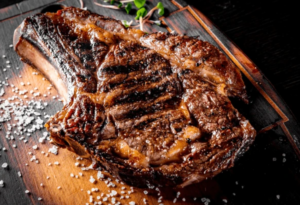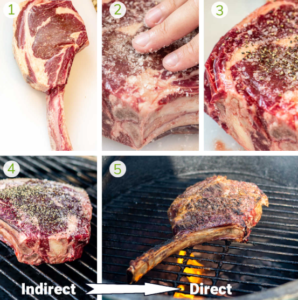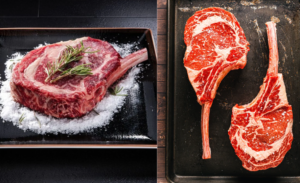The cowboy ribeye is more than just a steak—it’s a bold symbol of flavor and tradition. Celebrated for its rich marbling and signature bone-in design, this steak reflects the culinary heritage of the American West. So, why is it called a cowboy ribeye? To understand, we need to explore its history and the traits that make it special.
Not only does this steak embody the rugged charm of frontier life, but it also highlights the practicality of cowboy cooking methods. Furthermore, its bone-in structure enhances both flavor and visual appeal, ensuring it stands out among other steak cuts. As a result, the name perfectly captures its blend of tradition and boldness.
What Is a Cowboy Ribeye Steak?

A cowboy ribeye is a thick, bone-in ribeye steak prized for its rich marbling and hearty flavor. Additionally, the retained rib bone contributes to its rustic charm and enhances the taste during cooking. For those who love bold flavors, this cut offers a satisfying dining experience.
To learn more about its historical context, check out the Culinary Traditions of the Wild West. For comparisons with other steak cuts, explore this guide on the difference between ribeye and cowboy steak.
The Cowboy Connection
The term « cowboy » is deeply tied to the rugged lifestyle of ranchers who thrived on hearty meals during long days of herding cattle. These cowboys often prepared their meals over open flames, relying on substantial cuts of meat to sustain their energy. The cowboy ribeye, with its robust size and bone-in design, epitomizes this culinary tradition.
Learn about another hearty steak alternative, the cowboy steak, and its connection to rustic cooking methods.
Why the Name ‘Cowboy Ribeye’?
The name “cowboy ribeye” reflects both practicality and tradition. Its rib bone serves as a natural handle, making it easy to eat in outdoor settings—especially useful for cowboys dining without utensils. Additionally, the name captures the steak’s connection to the rugged, no-frills lifestyle of the American West.
Curious about pricing? This article on cowboy steak price explained offers valuable insights. For a historical perspective, visit the History of Ribeye Steak.
Cooking Techniques for the Cowboy Ribeye

The cowboy ribeye is versatile, and various cooking methods enhance its bold flavor:
- Grilling: A traditional method that adds a smoky, charred crust.
- Reverse-searing: A modern technique combining slow cooking with a high-heat finish.
- Broiling: An excellent alternative for achieving grill-like results indoors.
For step-by-step instructions, explore this resource on how to cook cowboy steak.
Cowboy Ribeye vs. Other Bone-In Steaks

While the cowboy ribeye shares similarities with other cuts, its bone-in feature and robust size set it apart:
- Tomahawk Steak: A similar cut but with a longer bone, making it more dramatic in appearance.
- Standard Ribeye: Boneless and slightly easier to cook but lacks the rustic appeal of the cowboy ribeye.
FAQs About the Cowboy Ribeye Name
Why is it called a cowboy ribeye?
The name comes from its association with cowboy cooking and the practicality of its bone-in design.
Is the cowboy ribeye healthier than other steaks?
Its nutritional value is similar to other ribeye cuts, but its marbling ensures superior flavor.
How can I cook a cowboy ribeye without a grill?
Pan-searing or broiling are excellent alternatives.
Conclusion
The cowboy ribeye is more than just a steak—it’s a tribute to the culinary traditions of the American West. Its bold flavors, cultural connections, and versatile cooking methods make it a must-try for steak enthusiasts. Whether you’re grilling outdoors or cooking in your kitchen, this steak delivers an unforgettable dining experience.
Explore more about cowboy cuts and techniques with the wealth of resources available on The Recipe Stream.
